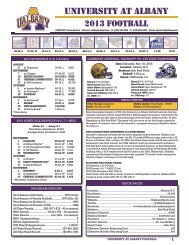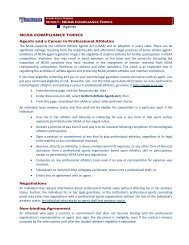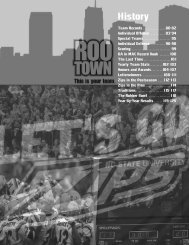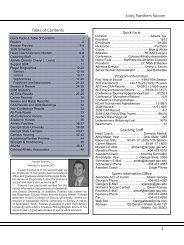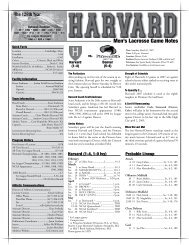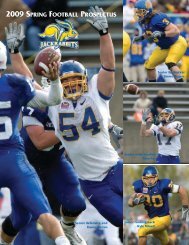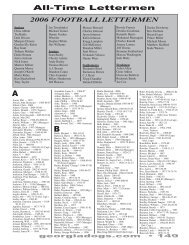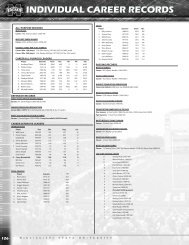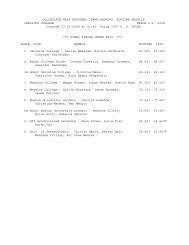Wrestling layout 04-05 - Home Page Content Goes Here
Wrestling layout 04-05 - Home Page Content Goes Here
Wrestling layout 04-05 - Home Page Content Goes Here
Create successful ePaper yourself
Turn your PDF publications into a flip-book with our unique Google optimized e-Paper software.
The history of athletics at Hofstra is as old as the University itself,<br />
and is steeped in the Dutch heritage that helps to make Hofstra<br />
such a unique school.<br />
Hofstra has always had strong roots in tradition. Ties to Dutch heritage<br />
and the Netherlands began with William S. Hofstra, after whom the<br />
school is named and on whose property the University was started.<br />
William Hofstra died in 1932 and when his wife, Kate, died 16 months<br />
later, her will provided that their house, 15-acre estate, and bulk of her<br />
inheritance were to be used for a “public, charitable, benevolent, or<br />
scientific purpose” as a memorial to her husband.<br />
The idea for a college came from Truesdel Peck Calkins, former<br />
Hempstead superintendent of schools, who was then with New York<br />
University. He suggested that NYU might offer extension courses on the<br />
Hofstra property. Hofstra opened in September 1935, as a two-year<br />
extension branch of NYU; its official name was “Nassau College –<br />
Hofstra Memorial of New York University at Hempstead, Long Island.”<br />
HOFSTRA HERITAGE<br />
When the doors opened, the sole building on campus was Hofstra’s<br />
mansion, which he had affectionately named the Netherlands after his<br />
homeland, and all classes were held there. The mansion, which houses<br />
administrative offices, is now the center of Hofstra’s 240-acre campus,<br />
and has been renamed Hofstra Hall.<br />
Also adopted in this early stage of Hofstra’s history was the school alma<br />
mater, “The Netherlands.” The lyrics were written by a faculty member to<br />
the music of the Dutch national anthem by the 16th-century Dutch<br />
composer Valerius.<br />
THE HOFSTRA FLAG<br />
The Hofstra storm flag is modeled after an actual Dutch geus, a<br />
privateer’s flag. In 1991 a representative of Holland’s Queen Beatrix<br />
presented the banner to then Hofstra President (now President<br />
Emeritus) James M. Shuart. The history of the flag dates back to 1572,<br />
when a group of Dutch loyalists called Watergeuzen used the flag’s mast<br />
to ram the gates of a Dutch city in their opposition to Spanish rule.<br />
While the Netherlands Royal Navy flies the original red, white and blue<br />
geus, the Hofstra version has been redesigned in the school colors of<br />
gold, white and blue.<br />
The gold, white and blue Hofstra colors themselves spring from Dutch<br />
roots. The first official Hofstra flag appeared on April 19, 1940, when Dr.<br />
Alexander Loudon, an envoy for Queen Wilhelmina of the Netherlands,<br />
presented his country’s flag to Hofstra in a special ceremony. However,<br />
the flag he presented was not the red, white and blue flag of the<br />
Netherlands, but the orange, white and blue banner of William of Nassau<br />
with a Hofstra emblem placed on the flag. The University has used the<br />
design ever since, although President Shuart, after researching the<br />
colors, replaced the orange hue with gold, making the flag truer to the<br />
original House of Nassau. The flag is one of Hofstra’s most recognizable<br />
symbols, utilized in publications, pins and souvenirs.<br />
THE HOFSTRA SEAL<br />
The Hofstra seal, another easily recognizable emblem, was designed<br />
from the royal Dutch emblem by art instructor<br />
Constant Van de Wall. The seal is<br />
modeled on the coat of arms of the<br />
House of Orange-Nassau. The<br />
round seal includes the coat of<br />
arms, flanked by lions on<br />
either side. A lion also stands<br />
in the center of the coat of<br />
arms, holding a sword in its<br />
right claw and a bundle of<br />
seven arrows, which<br />
represent the seven provinces<br />
of Holland, in its left. The seal<br />
also carries the motto of the<br />
House of Orange-Nassau in Old<br />
French: “Je maintiendray” (I stand<br />
HOFSTRA PRIDE WRESTLING<br />
WRESTLING<br />
33



